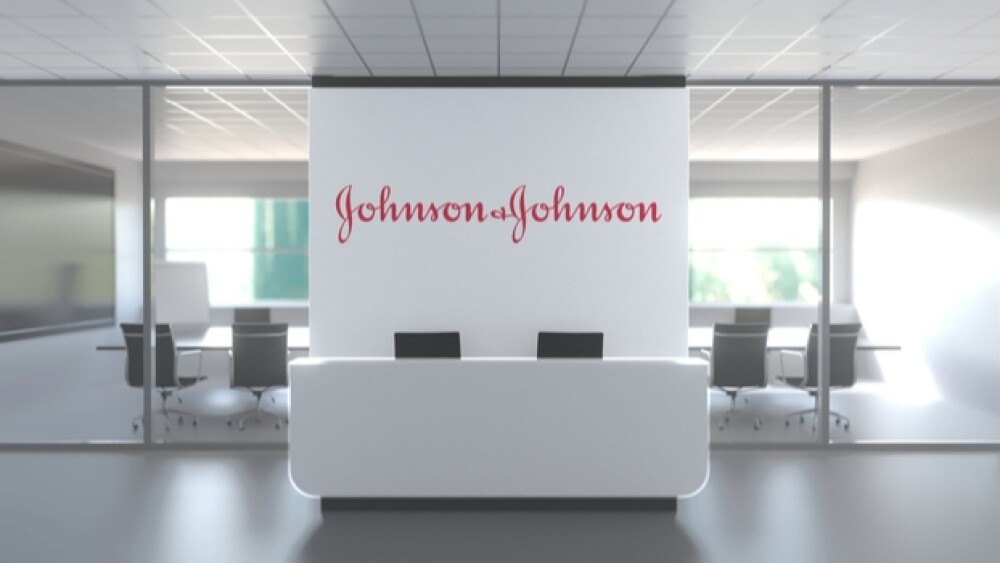A week after announcing its intention to spin off its consumer health division, J&J revealed ambitious plans for its pharmaceutical business.
Novikov Aleksey/Shutterstock
One of the world’s most iconic healthcare brands, Johnson & Johnson, is splitting up. But it’s a good thing! That seems to be the general consensus so far. Better for the children: J&J’s consumer group, pharmaceuticals, and medical devices.
A week after announcing its intention to spin off its consumer health division that sells, among other products, Listerine and Band-Aid, the American multinational revealed ambitious plans for its pharmaceutical business. The move was made to focus on pharmaceuticals through its Janssen Pharmaceutical unit and medical devices with Ethicon and DePuy. On Thursday, at its Pharmaceutical Business Review day, Dr. Mathai Mammen, global head of R&D at Janssen, shared that J&J expects to file for approval of 14 new drugs by 2025. He also projected average peak sales of $4 billion a year for each potential blockbuster, for a total of $56 million in overall revenue.
In an interview, Mammen appeared to separate this statement from last week’s transaction, saying, “We’re really happy and proud of the way R&D is functioning
—the strategy we’re using and the level of investments.” In particular, Mammen highlighted a non-small-cell lung cancer (NSCLC) drug, a respiratory syncytial virus (RSV) vaccine, and an anticoagulant it is developing in partnership with Bristol Myers Squibb. And while J&J’s COVID-19 single-shot vaccine was made using adenovirus vector technology, Mammen said the company is “actively looking” at many different platforms, including messenger RNA (mRNA), the technology used in the more commercially successful vaccines made by Moderna and Pfizer-BioNTech.
Whether the two announcements are related or not, it is an exciting time for the 135-year-old household name. Talc lawsuits and the inherent risks of drug development aside, J&J appears to be set up for success over the coming decade.
BioSpace sat down with former J&J executive Steven Robins, currently managing partner & principal at the New England Consulting Group, to learn more about the rationale behind the separation.
“There’s always been discussion, particularly from Wall Street, about unlocking the value of getting a pure-play med device/pharma company, because the multiples are higher than they are in the consumer world,” said Robins, who was general manager of J&Js consumer healthcare business unit in Canada following the 2006 acquisition of Pfizer’s consumer healthcare business. “I think they got to the point where the gross differential between [the pharma/med device] group and the consumer group was too great to not unlock that value.”
Johnson & Johnson’s credo begins, “We believe our first responsibility is to the patients, doctors, and nurses, to mothers and fathers and all others who use our products and services.” From Robins’ experience, this is more than just lip service at J&J.
“There was a real commitment on J&J’s part to try to understand the patient from the beginning to the end of their journey through healthcare,” he said, pointing to diabetes as one area where the company was really hoping to find specific business synergies between the divisions. “It’s the only place I’ve ever seen brings that to a meeting and says, ‘Well, wait a second. Even though this decision may make sense financially, what does it do to these stakeholders? And none of them are stockholders. [They] are the people that use and interact with the products.”
In this same vein, J&J may now have the potential to navigate into therapeutic spaces not thought to be in line with the consumer business.
“It allows them to get into therapeutic areas that may be controversial more quickly,” Robins said. “Management was always concerned about anything that could affect the equity that J&J had built with moms and dads. I think pharma can now pursue more avenues without having to consider the consumer impact, as opposed to the scientific interpretation.” He added that giving up on achieving acceleration synergies will enable a more pure medical device strategy.
For the consumer group, Robins said the separation should allow J&J to “to compete … in a much more aggressive way,” free of the constraints it currently faces working across regulatory classifications. “The claims they can make, the way they can go to market, even if that includes getting doctors to recommend products
—all of that becomes easier than when they had to live up to pharma standards because of J&J’s pharma products.”
As with any major reshuffle, there will be challenges as well. The first one, Robins said, will be to “unwind” all the intricacies of a consumer group that has been a part of the company since its inception.
“Depending on the financial structures of all of those acquisitions, including things like where the goodwill sits, which division actually bought the entity, they have a very heavy lift over the next 18 to 24 months,” he stated.
The cultural icons will also need to be untangled. J&J is one of America’s most iconic household names, and it would be anticipated that all three sections would want to keep the name.
“What will the consumer division be called?” Robins asked. “There’s obviously a ton of equity in that name.”
There will also inevitably be impacts from a personnel standpoint. Traditionally, J&J has been “best-in-class” at allowing its employees to move across divisions in search of different opportunities, Robins said. This is an attractive element that could be lost in the split, particularly when it comes to the consumer group. “You’re likely to see more people moving out of J&J a year or two down the road when they’re looking for their next career opportunity.”






